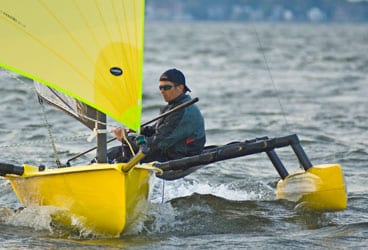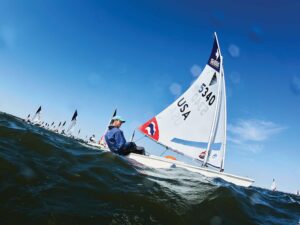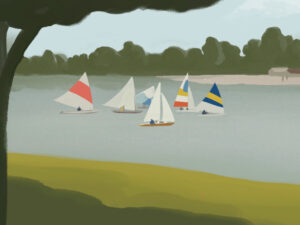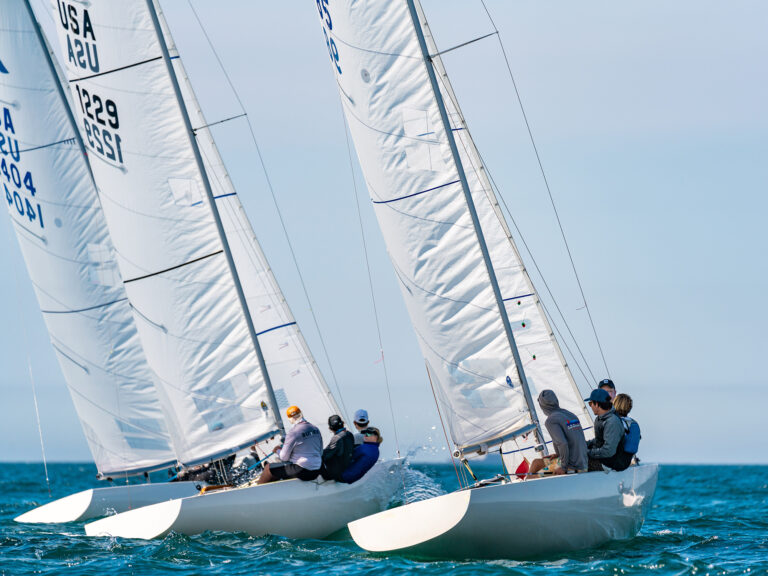
Dave Reed sailing
Until recently, I knew of Ted Turner only what can be found in his memoir, Call Me Ted: media tycoon and pioneer, charitable do-gooder, land conserver, and one seriously feisty and skilled sailor. I got a full dose of this last trait when I sailed on board American Eagle at the 12-Meter North Americans in September.
Ted built his reputation as one of the best ocean-racing skippers of the early 1970s with American Eagle, but he hadn’t sailed the red-hulled Luders design in 35 years, nor had he done any racing of late. After less than 30 minutes behind the wheel on our practice day, he proclaimed the speedo was off by a fraction or two, prompting the boat’s owner, Herb Marshall, to fetch the electronics manual and fix the problem.
His longtime friend and tactician, Gary Jobson, started the regatta’s first four races but surrendured the wheel to Ted thereafter. It took a few laps before Ted hit his stride, but when he did so, the boat felt alive. From behind his sunglasses, I could sense he was in tune with the telltales, the yarns on the shrouds, and the speedo. He didn’t need to be told whether he was too high or too low. He knew exactly how to coax the ol’ girl around the racecourse.
On the last day of the regatta, he was more talkative and feisty. Maybe he felt more confident after a few races, or maybe it had something to do with our desire to beat a faster Columbia—a feat the American Eagle regulars had failed to do all summer long on the 12-Meter circuit.
On this two-race day, Gary relinquished the starts to Ted, who nailed the first one, crossing the line with speed, and with Columbia and Easterner in his hip pocket. Our lead quickly grew, at which point Ted looked over his shoulder and declared, “Hot damn! Look at that! Hee-hee.”
During the second start, Ted deftly stuffed Easterner in the final 30 seconds and forced Columbia, to weather of Easterner, over the line. At 10 seconds, he put the bow down and was on pace when the gun fired. The lead was ours to protect, and, as we later neared the port layline, Ted grew anxious.
“I want to tack, Gary,” he said. “We’ve gone too far, damn it.”
“No, Ted. We’re fine,” Gary responded, all cool and collected. “Not yet. Give it a few more boatlengths.”
Ted wouldn’t have it, and promptly barked, “Tacking!”
He heaved the wheel to starboard, and, soon after, our bow passed the mark by mere feet. He was spot-on with his layline call. Incredible. When was the last time he’d called a layline?
As we sailed the final beat, a good leg ahead of Columbia, a squall arrived and the wind escalated into the high 20s. We were way overcanvassed, and the rivet-riddled aluminum mast shook violently as the sails flogged. I know what everyone else what thinking, myself included . . . but it didn’t seem to faze Ted one bit.
With the regatta all but won, all we had to do was turn the corner and finish. But first, we had to jibe. Gary suggested the prudent move.
“Ted, after the rounding, we’re not going to jibe. We’re going to tack,” he said.
The mere suggestion of a tack dumfounded Ted.
“Tack? Whadda ya mean, tack?”
“We’re going tack the boat, Ted,” said Gary.
“We’re not tacking!” was his angry retort. “I’m the damn skipper . . . we’re gonna jibe . . . jibing!”
He turned the wheel, and the main hesitated before swinging across and smacking the water with a shuddering thud. In that very moment, there was a long collective gasp in anticipation of the rig tumbling down, but when I glanced back at Ted, he was grinning, confident and obstinate as ever.
Dave Reed
editor@sailingworld.com









